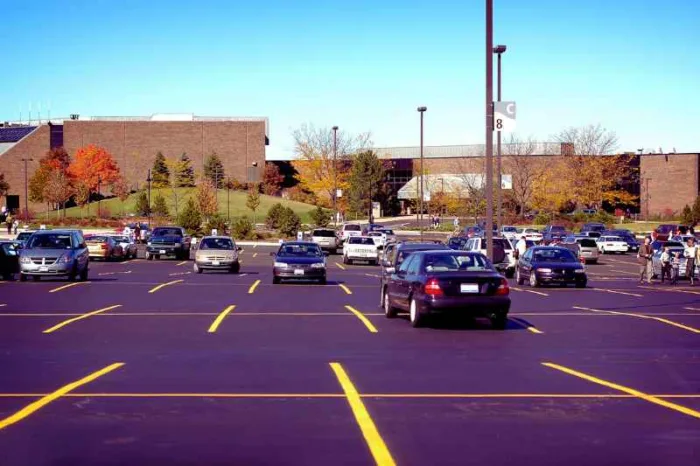Key takeaways
- Three top visitor parking problems at a condo include guests parking in resident spots, traffic, and visitors blocking residents in.
- The benefits of a parking management system for condos are that each resident gets a fair number of spaces, only registered cars are on the property, and the parking area is safer from crime.
- Alternative parking management solutions for guests include assigned parking spaces, registration forms, and proper signage.

Visitor parking management is one of the most difficult aspects of managing a condo building. Providing parking spaces for condo and HOA residents is one thing, but managing the flow of visitors is tricky. It’s also highly important because residents expect to have as many visitors as occupancy laws allow, and as the property manager, it’s up to you to make that happen.
This post will provide the best way to manage visitor parking at your building. Next, we’ll explain the most common visitor parking problems you want to know about. Lastly, we’ll go over a few alternative methods for condo visitor parking management.
This post covers:
- The best way to manage condo visitor parking
- Common condo visitor parking problems
- Benefits of HOA/condo visitor parking management systems
- Alternative condo visitor parking management methods
The best way to manage condo visitor parking
ButterflyMX offers vehicle access control and video intercoms to improve visitor and resident parking management. It has been installed in over 15,000 buildings and has over 40,000 five-star reviews.
The vehicle reader can be installed at gates, security checkpoints, and parking garage entranceways. Residents are assigned RFID tags that go onto their vehicles’ windshields. The reader then scans the RFID tag and lets residents onto the property without requiring any additional input. The reader helps to separate a resident-only parking lot from a visitor’s lot.
The ButterflyMX video intercom also offers features such as:
- Mobile entry. Residents can access a property even if they don’t have an RFID tag in their car. After downloading the ButterflyMX app, they must tap a button on their phone to gain access.
- Visitor Passes. Residents can assign Visitor Passes to guests and visitors. Visitor Passes are temporary access credentials available on a resident’s phone.
- Remote entry. Residents can remotely tap a guest onto their property with their mobile phone. This is great for when residents need pet sitters or have guests arriving while they are at work.
- Video communication. Residents can talk to guests and visitors and, most importantly, see who they are speaking with. This allows them to know who exactly they are letting onto the property.
- Management options. Property managers can remotely set access permissions for residents from their mobile devices. This is a great alternative to a time-consuming onboarding process.
Learn how to manage visitors with ButterflyMX’s front desk station:
Common Condo Visitor Parking Problems
More than five million American households live in condo buildings. With a high number of residents comes a high number of visitors. Many visitors are likely unfamiliar with condominium parking rules and regulations. Without condo parking enforcement, you will likely run into issues.
Condo visitor parking problems include:
- Visitors park in residential spaces. Most condominiums have specific parking spaces for residents. Without an organized condo visitor parking management system, visitors might park in resident spaces, which can cause all sorts of frustration.
- Parking on the lawn or in non-designated spaces. Visitors not knowing where to park can lead to them damaging your lawn or other aspects of your property.
- Cars that overstay their welcome. Nobody can abandon their car on your property without a proper management system. Visitors might also think storing their vehicles on your property is okay permanently.
- Unverified visitors. If you have no access control system, strangers who have no relation to anyone in the building may be able to access your property. This can also lead to security risks like car thefts or break-ins.
- Traffic. Confused visitors unsure where to park can cause a long line of cars on your property. If this line leads to the road, it could become a safety hazard that makes your property liable.

Benefits of HOA/condo visitor parking management systems
Now that we’ve covered all of the headaches that a lack of a visitor parking management system can bring let’s explore the benefits of an efficient system.
Benefits include:
- Fast entry. Both residents and visitors alike will benefit from quick entry to your property.
- Secured vehicles. Residents and visitors will feel safer leaving their vehicles in a parking lot with a management system that also serves as a security system.
- 24/7 access. A good parking management system will allow residents and guests to secure access day or night without restrictions. However, if you deem this necessary, you can still include no overnight parking in your HOA guest parking rules.
- Commercial parking. In addition to providing parking for visitors, a good parking management system will also cater to commercial vehicles. Commercial vehicles include postal delivery trucks and specialized vehicles for contractors such as plumbers and electricians.
Alternative condo visitor parking management methods
Additional ways to manage parking at a condo complex include:
Assigned parking spaces
First-come, first-served parking spots don’t benefit your residents or visitors in any way. Instead, assigned parking spaces allow residents to know exactly where they are going to park. Furthermore, assigned spaces for visitors are a good way for residents to know where to direct their visitors before they arrive.
Clear signage
Believe it or not, clear parking signage plays a big role in getting people to park where you want them to. Choose parking signs with clear language that direct visitors where to park specifically. You’ll want multiple signs so that guests can’t possibly miss them. We recommend including a sign near the entrance to your parking facility. Additionally, place signs over the exact area where you expect visitors to park.
Want to know what else what else works when it comes to signage? The threat of a car being towed, booted, or ticketed. If your signage implies an “or else” if rules aren’t followed, then it’s a guarantee most people will follow your instructions. The best part of this is that you don’t have to go through the trouble of towing cars that break the rules. Instead, we recommend that you give people a warning.

Physical parking passes
Physical parking passes often take the form of laminated cards that residents and their visitors can place on their dashboards when they park. A parking pass will indicate a date and time in which a vehicle is allowed to park at your building. Parking attendants then go around ensuring that parking passes aren’t expired. The problem with this visitor parking solution is that you have to put staff members on parking duty, which can be a costly building expense.
Parking reservation systems
In some cases, a parking reservation system for visitors is a good idea. Residents can register their intended visitors in advance, and when visitors arrive, there will be a designated parking space for them. The problem with a reservation system is that a resident may wish to have a visitor, but when they go to the reservation system, they’re forced to alternate their plans. Residents own their condos and want a fair amount of freedom when it comes to having visitors. A reservation system might be too restrictive.

Get your free quote!
Fill in the form below, and we'll email you right back.
Want a free quote?
Fill in the form below, and we'll email you right back.
You’ll be redirected shortly...






